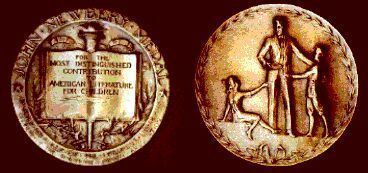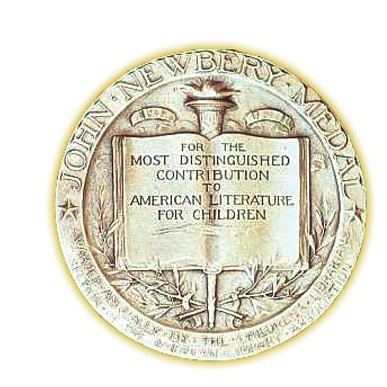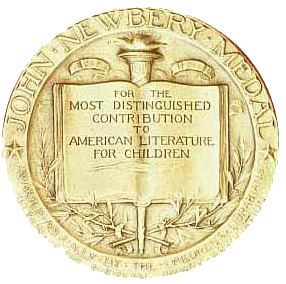Country United States Established 1922 | Official website ala.org/alsc/newbery First awarded 1922 | |
 | ||
Awarded for "The most distinguished contribution to American literature for children" Ceremony date January 23, 2017, 5:00 AM PST People also search for | ||
Newbery medal books
The John Newbery Medal is a literary award given by the Association for Library Service to Children, a division of the American Library Association (ALA). The award is given to the author of "the most distinguished contribution to American literature for children." Named for John Newbery, an 18th-century English publisher of juvenile books, the Newbery was proposed by Frederic G. Melcher in 1921, making it the first children's book award in the world. The medal was designed by Rene Paul Chambellan and depicts an author giving his work (a book) to a boy and a girl to read.
Contents
- Newbery medal books
- History
- Selection process
- Controversy
- Multiple awards
- Newbery Medals
- Medal and Honor
- Multiple Honor Books
- References

The Newbery and the Caldecott Medal are considered the two most prestigious awards for children's literature in the United States. Many bookstores and libraries have Newbery sections; popular television shows interview the winners; textbooks include lists of Newbery winners, and many master's and doctoral theses are written about them.

Beside the Newbery Medal, the committee awards a variable number of citations to worthy runners-up, called Newbery Honors or Newbery Honor Books. Runners-up had been identified annually from the start, with a few exceptions only during the 1920s; all those runners-up were named Newbery Honor Books retroactively, when the "Honor" was introduced 1971, and may display the Newbery Honor Seal. As few as zero and as many as eight have been named, but from 1938 the number of Honors or runners-up has been one to five. The Honor Books must be a subset of the runners-up on the final ballot, either the leading runners-up on that ballot or the leaders on one further ballot that excludes the winner.

Every book considered must be written by a United States citizen or resident and must be published first or simultaneously in the United States in English during the preceding year.
History
The Newbery Medal was established June 22, 1921, at the annual conference of the American Library Association. Proposed by Publishers Weekly editor Frederick Melcher, the idea was enthusiastically received by the children's librarians present. The award was administered by the ALA from the start, but Melcher provided much needed funds that paid for the design and production of the medal. The Newbery Medal was inaugurated in 1922, considering books published in 1921. In retrospect it is officially dated 1922 and that convention is followed here. According to The Newbery and Caldecott Awards—the official guide, updated annually—Melcher and the ALA Board agreed to establish the award for several reasons that related to children's librarians. They wanted to encourage quality, creative children's books and to demonstrate to the public that children's books deserve recognition and praise. In 1932 the committee felt it was important to encourage new writers in the field, so a rule was made that an author would win a second Newbery only if the vote was unanimous. The rule was in place until 1958 and Joseph Krumgold became the first winner of two Newberys in 1960. Another change, in 1963, made it clear that joint authors of a book were eligible for the award. Several more revisions and clarifications were added in the 1970s and 1980s.
Selection process
As Barbara Elleman explained in The Newbery and Caldecott Awards, the original Newbery was based on votes by a selected jury of Children's Librarian Section officers. Books were first nominated by any librarian, then the jury voted for one favorite. Hendrik van Loon's non-fiction history book The Story of Mankind won with 163 votes out of 212. In 1924 the process was changed, and instead of using popular vote it was decided that a special award committee would be formed to select the winner. The award committee was made up of the Children's Librarian Section executive board, their book evaluation committee and three members at large. In 1929 it was changed again to the four officers, the chairs of the standing committees and the ex president. Nominations were still taken from members at large.
In 1937 the American Library Association added the Caldecott Award, for "the artist of the most distinguished American picture book for children published in the United States". That year an award committee selected the medal and honor books for both awards. In 1978 the rules were changed and two committees were formed of fifteen people each, one for each award. A new committee is formed every year,with "eight elected, six appointed, and one appointed Chair". Committee members are chosen to represent a wide variety of libraries, teachers and book reviewers. They read the books on their own time, then meet twice a year for closed discussions. Any book that qualifies is eligible; it does not have to have been nominated. Newbery winners are announced at the Midwinter Meeting of the American Library Association, held in January or February. The results of the committee vote are kept secret, and winners are notified by phone shortly before the award is announced.
Controversy
In October 2008, Anita Silvey, a children's literary expert, published an article in the School Library Journal criticizing the committee for choosing books that are too difficult for children. Lucy Calkins, the Reading and Writing Project at Columbia University's Teachers College, agreed with Silvey: "I can't help but believe that thousands, even millions, more children would grow up reading if the Newbery committee aimed to spotlight books that are deep and beautiful and irresistible to kids". But Pat Scales said, "The criterion has never been popularity. It is about literary quality. How many adults have read all the Pulitzer-prize-winning books and ... liked every one?"
John Beach, associate professor of literacy education at St. John's University in New York, compared the books that adults choose for children with the books that children choose for themselves and found that in the past 30 years there is only a 5% overlap between the Children's Choice Awards (International Reading Association) and the Notable Children's Books list (American Library Association). He has also stated that "the Newbery has probably done far more to turn kids off to reading than any other book award in children's publishing."
Erica Perl responded that "For starters, the real reasons kids don't read doesn't have anything to do with the Newbery medal—or any award. It has to do with the declining role of the book in our streaming-media culture and with socioeconomic realities."
Multiple awards
Robert Lawson alone has won both a Newbery Medal and a Caldecott Medal. Sharon Creech and Neil Gaiman have won both a Newbery Medal and a Carnegie Medal, the equivalent British award. Scott O'Dell and Jean Craighead George have won both a Newbery Medal and a Deutscher Jugendliteraturpreis, the equivalent German award.
Newbery Medals
Six authors have won two Newbery Medals.
Medal and Honor
Many authors have won both the Newbery Medal and the Honor.
